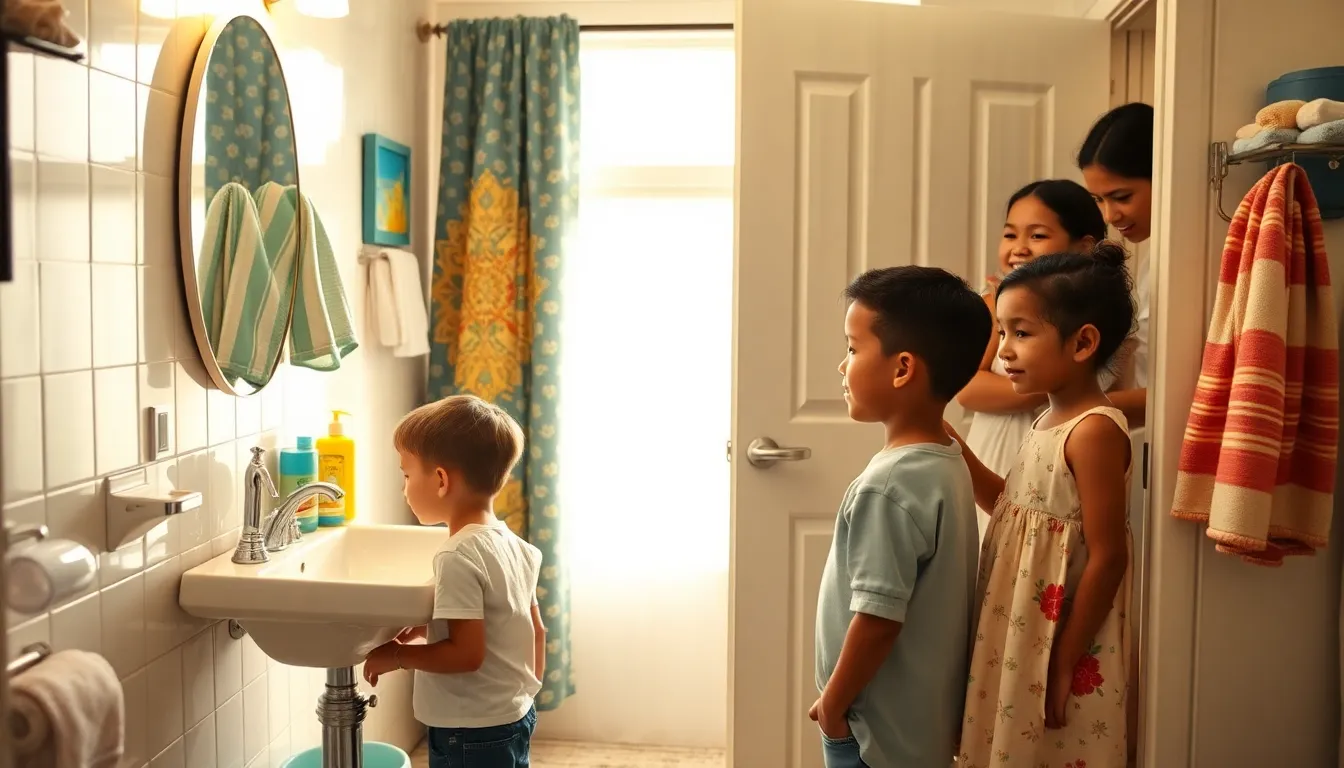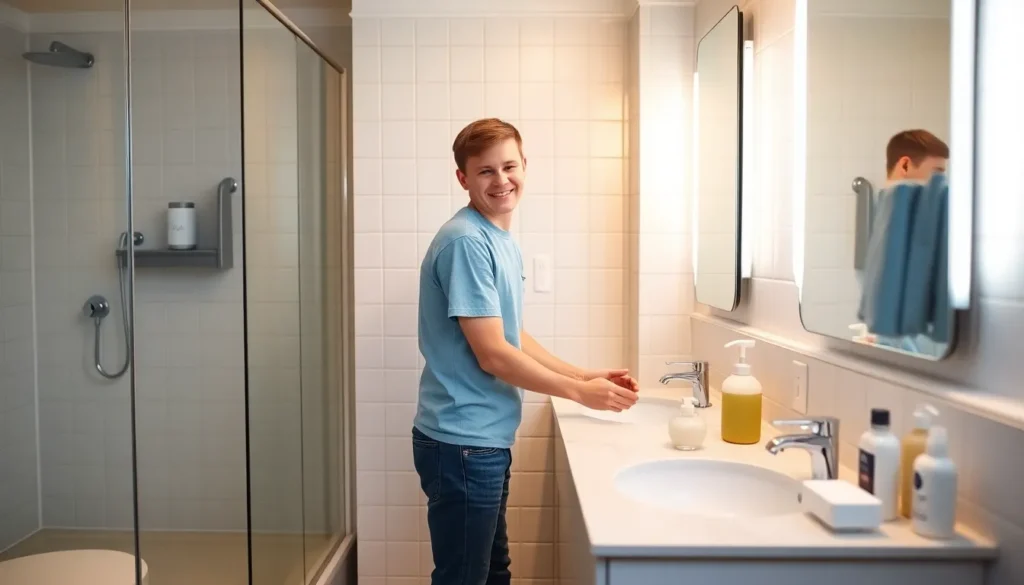Navigating bathroom etiquette can feel like a high-stakes game of Tetris. With limited space and a variety of personal needs, understanding bathroom order is crucial for maintaining harmony in shared spaces. Whether it’s a family home or a bustling office, knowing who goes first can save everyone from awkward encounters and potential chaos.
Imagine a world where everyone respects the unspoken rules of the restroom. No more knocking on locked doors or awkward standoffs in the hallway. By mastering the art of bathroom order, individuals can ensure a smoother experience for everyone involved. So, let’s dive into the dos and don’ts that will transform your bathroom visits from a potential minefield into a well-orchestrated symphony of efficiency. After all, a little organization can go a long way in the quest for peace and quiet in the throne room.
Table of Contents
ToggleUnderstanding Bathroom Order
Bathroom order plays a crucial role in shared spaces like homes and offices. Recognizing proper etiquette enhances the restroom experience for everyone involved.
Importance of Bathroom Order
Establishing a sense of order in bathrooms ensures that individuals respect each other’s privacy. A clean and organized restroom promotes a pleasant atmosphere that reduces tensions. Efficient bathroom order minimizes wait times, especially in busy environments. Respecting basic rules fosters a cooperative spirit among users. A well-maintained space encourages a sense of responsibility, which enhances overall hygiene.
Factors Influencing Bathroom Order
Several factors directly impact bathroom order. Space availability influences how users navigate and utilize facilities. The number of visitors at any given time determines demand on resources like stalls, sinks, and supplies. Cultural norms often dictate behaviors and expectations regarding restroom use. Signage can guide individuals on proper etiquette, thus reinforcing order. Cleanliness levels largely affect user comfort, thus impacting the overall environment.
Common Bathroom Order Scenarios

Understanding common bathroom order scenarios promotes smoother interactions in shared spaces. Different environments call for specific considerations.
Family Bathroom Use
Family bathrooms often feature multiple users. Scheduling bathroom times benefits all family members, reducing conflicts. Parents can teach children simple rules, like knocking before entering. Children also gain patience by waiting their turn. Establishing a routine helps everyone anticipate busy times, such as mornings before school. Cleaning habits play a crucial role, too. Regularly sanitizing surfaces encourages everyone to contribute, fostering responsibility.
Shared Bathroom Situations
Shared bathrooms, such as those found in offices or public areas, require extra mindfulness. Users should remember to leave things tidy after use; this creates a pleasant space for the next person. Respecting time limits is essential, especially during peak hours. Individuals can benefit from organization by keeping personal items in designated areas. Additionally, clear signage can remind users of proper etiquette. Understanding the importance of these norms promotes a cooperative environment, easing pressure during busy times.
Strategies for Maintaining Bathroom Order
Maintaining bathroom order requires effective strategies that promote cleanliness and organization. Implementing organized practices can significantly improve restroom experiences.
Organizational Tips
Create designated storage for personal items, using baskets for toiletries. Label shelves and drawers to assist in finding items promptly. Encourage family members to return items to their designated spots after use. Limit the number of personal items in shared bathrooms to minimize clutter. Establish a simple routine where users check the space before exiting. Consider using clear containers for visibility while keeping products accessible.
Cleaning Routines
Set a cleaning schedule, designating specific days for deep cleaning. Enlist all users in maintaining cleanliness through a shared chore chart. Regularly inspect supplies, replacing toilet paper and hand soap as needed. Use disinfectant wipes for quick cleanups between major cleans. Address spills or messes immediately to prevent buildup. Encourage everyone to do a quick wipe-down after use to keep surfaces tidy.
Benefits of a Well-Ordered Bathroom
A well-ordered bathroom enhances the overall experience for users. Improved efficiency results from organized layouts that minimize time spent searching for items or waiting for access.
Improved Efficiency
Organized bathrooms significantly increase efficiency. Users quickly find toiletries and cleaning supplies thanks to designated storage solutions. Reduced clutter accelerates the transition from one task to another. Clear signage helps identify different areas, such as sinks or stalls, minimizing confusion during busy times. Scheduling usage also plays a role in optimizing efficiency, particularly in shared spaces like offices. Families benefit from assigning specific time slots, reducing conflicts over bathroom access.
Enhanced Hygiene
Enhanced hygiene stems from an organized bathroom environment. Clean bathrooms tend to have lower levels of germs and bacteria, contributing to healthier experiences. Regular cleaning schedules ensure surfaces remain sanitized, especially in high-traffic areas. Users are more inclined to keep uneaten items in designated storage, minimizing the risk of contamination. Consistent cleaning routines foster responsibility and encourage respect for shared spaces. Incorporating disinfectant wipes makes quick cleanups feasible, promoting continuous cleanliness throughout the day.
Maintaining bathroom order is crucial for creating a pleasant and efficient environment. By respecting etiquette and implementing simple strategies, individuals can significantly enhance their restroom experiences. A clean and organized bathroom not only promotes hygiene but also fosters a spirit of cooperation among users.
By encouraging responsibility and establishing routines, everyone can contribute to a more harmonious shared space. Whether in homes or offices, prioritizing bathroom order leads to reduced tensions and a smoother flow during peak times. Ultimately, embracing these practices helps ensure that all users feel comfortable and respected in shared restroom facilities.



